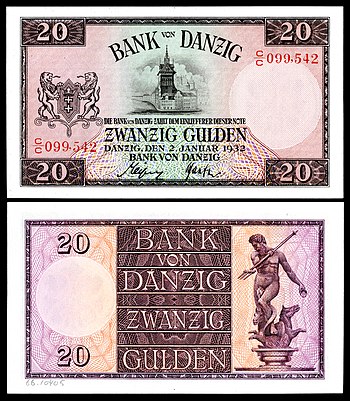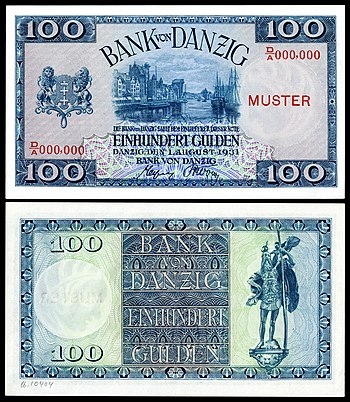Talk:Danzig gulden
| This article is rated Start-class on Wikipedia's content assessment scale. It is of interest to the following WikiProjects: | |||||||||||||||||||||||||||||||
| |||||||||||||||||||||||||||||||
External links modified[edit]
Hello fellow Wikipedians,
I have just modified one external link on Danzig gulden. Please take a moment to review my edit. If you have any questions, or need the bot to ignore the links, or the page altogether, please visit this simple FaQ for additional information. I made the following changes:
- Added archive https://web.archive.org/web/20140522215010/http://www.ostsee-urlaub-polen.de:80/gdansk/geschichte-geld.htm to http://www.ostsee-urlaub-polen.de/gdansk/geschichte-geld.htm
When you have finished reviewing my changes, please set the checked parameter below to true or failed to let others know (documentation at {{Sourcecheck}}).
This message was posted before February 2018. After February 2018, "External links modified" talk page sections are no longer generated or monitored by InternetArchiveBot. No special action is required regarding these talk page notices, other than regular verification using the archive tool instructions below. Editors have permission to delete these "External links modified" talk page sections if they want to de-clutter talk pages, but see the RfC before doing mass systematic removals. This message is updated dynamically through the template {{source check}} (last update: 18 January 2022).
- If you have discovered URLs which were erroneously considered dead by the bot, you can report them with this tool.
- If you found an error with any archives or the URLs themselves, you can fix them with this tool.
Cheers.—InternetArchiveBot (Report bug) 17:59, 6 December 2016 (UTC)
File:DAN-58-Bank von Danzig-10 Gulden (1930).jpg scheduled for POTD[edit]
Hello! This is to let editors know that the featured picture File:DAN-58-Bank von Danzig-10 Gulden (1930).jpg, which is used in this article, has been selected as the English Wikipedia's picture of the day (POTD) for January 16, 2021. A preview of the POTD is displayed below and can be edited at Template:POTD/2021-01-16. For the greater benefit of readers, any potential improvements or maintenance that could benefit the quality of this article should be done before its scheduled appearance on the Main Page. If you have any concerns, please place a message at Wikipedia talk:Picture of the day. Thank you! Cwmhiraeth (talk) 12:21, 26 December 2020 (UTC)

|
The Danzig gulden was the currency of the Free City of Danzig (present-day Gdańsk, Poland) between 1923 and 1939. Inflation in Danzig during 1922 had spiralled out of control, and the city abandoned the German Papiermark in favour of the Danzig gulden the following year. The issuance of the new gulden was overseen by the Bank of Danzig, established in early 1924. The obverse of each note shows the city's coat of arms on the left and an important local architectural structure in the centre. This ten-gulden banknote, issued in 1930, bears an illustration of the Artus Court, previously a meeting place of merchants and a centre of social life, and now part of the Gdańsk History Museum. Other denominations:
Banknote design credit: Bank of Danzig; photographed by Andrew Shiva
Recently featured:
|

|
The Danzig gulden was the currency of the Free City of Danzig (present-day Gdańsk, Poland) between 1923 and 1939. Inflation in Danzig during 1922 had spiralled out of control, and the city abandoned the German Papiermark in favour of the Danzig gulden the following year. The issuance of the new gulden was overseen by the Bank of Danzig, established in early 1924. The obverse of each note shows the city's coat of arms on the left and an important local architectural structure in the centre. This twenty-gulden banknote, issued in 1932, bears an illustration of the Prison Tower located near Gdańsk's historic Golden Gate on the obverse. Other denominations:
Banknote design credit: Bank of Danzig; photographed by Andrew Shiva
Recently featured:
|

|
The Danzig gulden was the currency of the Free City of Danzig (present-day Gdańsk, Poland) between 1923 and 1939. Inflation in Danzig during 1922 had spiralled out of control, and the city abandoned the German Papiermark in favour of the Danzig gulden the following year. The issuance of the new gulden was overseen by the Bank of Danzig, established in early 1924. The obverse of each note shows the city's coat of arms on the left and an important local architectural structure in the centre. This twenty-five-gulden banknote, issued in 1931, bears an illustration of St. Mary's Church on the obverse. Other denominations:
Banknote design credit: Bank of Danzig; photographed by Andrew Shiva
Recently featured:
|

|
The Danzig gulden was the currency of the Free City of Danzig (present-day Gdańsk, Poland) between 1923 and 1939. Inflation in Danzig during 1922 had spiralled out of control, and the city abandoned the German Papiermark in favour of the Danzig gulden the following year. The issuance of the new gulden was overseen by the Bank of Danzig, established in early 1924. The obverse of each note shows the city's coat of arms on the left and an important local architectural structure in the centre. This fifty-gulden banknote, issued in 1931, bears an illustration of an 18th-century arcaded house on the obverse. Other denominations:
Banknote design credit: Bank of Danzig; photographed by Andrew Shiva
Recently featured:
|

|
The Danzig gulden was the currency of the Free City of Danzig (present-day Gdańsk, Poland) between 1923 and 1939. Inflation in Danzig during 1922 had spiralled out of control, and the city abandoned the German Papiermark in favour of the Danzig gulden the following year. The issuance of the new gulden was overseen by the Bank of Danzig, established in early 1924. The obverse of each note shows the city's coat of arms on the left and an important local architectural structure in the centre. This one-hundred-gulden specimen banknote, issued in 1931, bears an illustration of a dock scene beside the river Motława in the city centre on the obverse. Other denominations:
Banknote design credit: Bank of Danzig; photographed by Andrew Shiva
Recently featured:
|

|
The Danzig gulden was the currency of the Free City of Danzig (present-day Gdańsk, Poland) between 1923 and 1939. Inflation in Danzig during 1922 had spiralled out of control, and the city abandoned the German Papiermark in favour of the Danzig gulden the following year. The issuance of the new gulden was overseen by the Bank of Danzig, established in early 1924. The obverse of each note shows the city's coat of arms on the left and an important local architectural structure in the centre. This five-hundred-gulden banknote, issued in 1924, bears an illustration of the arsenal of Gdańsk on the obverse. Other denominations:
Banknote design credit: Bank of Danzig; photographed by Andrew Shiva
Recently featured:
|

|
The Danzig gulden was the currency of the Free City of Danzig (present-day Gdańsk, Poland) between 1923 and 1939. Inflation in Danzig during 1922 had spiralled out of control, and the city abandoned the German Papiermark in favour of the Danzig gulden the following year. The issuance of the new gulden was overseen by the Bank of Danzig, established in early 1924. The obverse of each note shows the city's coat of arms on the left and an important local architectural structure in the centre. This one-thousand-gulden banknote, issued in 1924, bears an illustration of Gdańsk's city hall on the obverse. Other denominations:
Banknote design credit: Bank of Danzig; photographed by Andrew Shiva
Recently featured:
|


